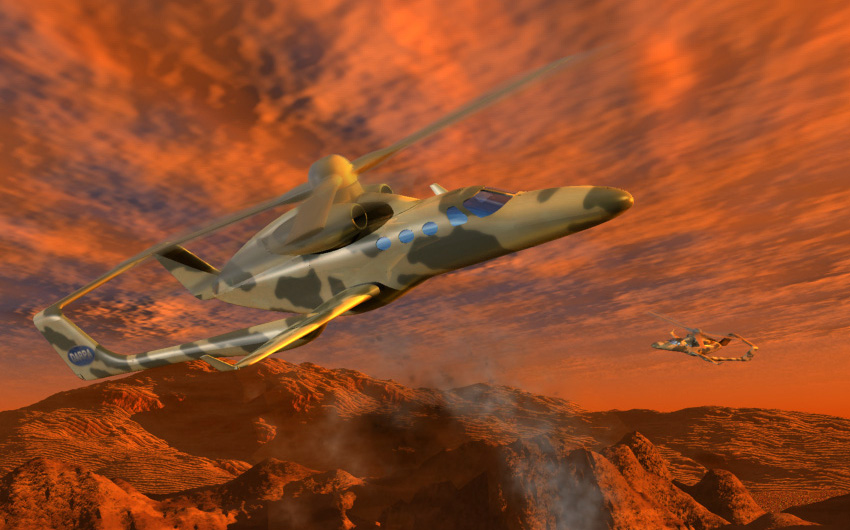Groen Brothers Aviation, Inc. (GBA) (OTCBB: GNBA) announced today that the U.S. Defense Advanced Research Projects Agency (DARPA) has passed GBA’s submission for the third Milestone of its contract to design a proof of concept high speed, long range, vertical takeoff and landing (VTOL) aircraft. Phase One is a fifteen month $6.4 million award to perform trade studies, develop appropriate risk mitigation, perform extensive advanced computer modeling of the entire vehicle, develop the preliminary design for the Heliplane and complete the rotor system design.
As previously announced, this modern rotorcraft, named by DARPA as the “Heliplane,” is designed to exploit GBA’s gyrodyne technology. A “gyrodyne” can be considered as an airplane that does not need a runway. It offers the VTOL capability of a helicopter, the fast forward flight of an airplane, and the safety, simplicity and reliability of a GBA gyroplane. The goal of this proof-of-concept demonstrator is a greater than two-fold improvement in speed and range performance over a conventional helicopter. The Heliplane will have a cruise speed of 400 mph and an unrefueled range of 1,000 nm (1,152 miles). The proof-of-concept aircraft will also carry a 1,000 lb payload.
The objective expressed by DARPA is to obtain performance out of a rotary-wing aircraft that is comparable with fixed-wing airplanes in speed and efficiency. This aircraft type could be the next generation rotor wing aircraft, meeting economy and performance goals not considered achievable by any other type of VTOL aircraft.
Salt Lake City based Groen Brothers Aviation’s team includes: The Georgia Institute of Technology, Atlanta; Adam Aircraft Industries with locations in both Colorado and Utah; Williams International with locations in both Michigan and Utah; and a highly renowned team of aerospace consultants including key members of the rotor-wing science cadre at Washington University in St. Louis, Penn State University, and the University of Maryland, as well as top rotor-wing scientists from throughout industry. On the Government Team under DARPA, the GBA team is receiving important support from NASA Ames and the Army’s AFDD team at NASA Ames Research Center in addition to leading Rotorcraft Technologists who for decades led much of this nation’s advanced rotor-wing aircraft development efforts.
Groen Brothers Aviation’s contract with DARPA is based upon the “gyrodyne” concept long espoused by Groen Brothers Aviation and extensively researched by Georgia Tech. A gyrodyne is similar in appearance to an airplane with a helicopter rotor mounted on top. And, like a helicopter it is capable of hovering and vertical takeoff and landing. Unlike a helicopter, however, a gyrodyne’s rotor is driven by rotor blade reaction drives powered only during hover, takeoff and landing. During forward flight, like a gyroplane, the rotor is not powered. Forward thrust is provided by engines typical of an airplane. This use of reaction drives for rotor power and main engines for forward thrust eliminates the need for much of the cost, weight, and complexity found in helicopters, while permitting much higher forward speeds.
Georgia Tech is a top U.S. graduate engineering research university, with premier aerospace engineering programs and its world famous rotary wing technology program. Adam Aircraft is highly respected for its innovative use of modern composite materials, engineering quality, and rapid prototyping processes that has allowed Adam to bring to market two new high-performance aircraft: the six passenger “center-line-twin” A500 and the A700 personal jet. Williams International has developed more than 40 different small gas turbine engine systems for both military and commercial air vehicles, including the Adam A700 and many other modern “biz-jets.” The University of Maryland, Penn State University, and Washington University, along with Georgia Tech, have long been leaders in rotor-wing sciences.
About Groen Brothers Aviation, Inc.
Developing gyroplane technology since 1986, GBA is recognized as the world’s leading authority on autorotative flight. The company has developed the world’s first commercially viable modern gyroplane — the first “autogiro” to utilize a jet engine — the Hawk 4 Gyroplane powered by a Rolls-Royce gas turbine engine. The Hawk 4 was used extensively for security aerial patrol missions during the 2002 Winter Olympics in Salt Lake City. The gyroplane’s inherently simple design offers a safe and affordable alternative to helicopters and airplanes for many applications, including aerial observation roles in both government and private applications, agricultural aerial application, tour guide flights, and cargo/passenger transport.
Through its American Autogyro division, the company has also developed and is currently selling a smaller kit gyroplane, the two seat “SparrowHawk II,” and is offering this aircraft as a safe, extremely economical Airborne Patrol Vehicle (APV) for law enforcement and other government applications. The Company is also developing a production two-seat gyroplane for both the “Airborne Law Enforcement” and the “Light Sport Aircraft” (LSA) markets. The Company continues to develop a nationwide dealership network for the sale of these products.

